Key Insights
- The volatility caused by FTX triggered $7 million in WBTC liquidations on Nov. 9, 2022. However, following the liquidation event, WBTC markets experienced a 283% surge in loan demand QoQ.
- USDT borrower and depositor rates spiked due to users taking advantage of a brief USDT depeg and volatility following the FTX collapse.
- In Q4, USDC retained the most favorable borrower rates and flipped DAI in outstanding loans for the first time.
- Outstanding loans on the recently launched Compound III doubled to over $76 million in Q4.
Primer on Compound
Launched in September 2018, Compound is a leading interest rate protocol that enables users to permissionlessly borrow and lend assets from a pool of collateral. The interest rates for these assets are set algorithmically using an interest rate model based on the proportion of assets lent out. This is known as the utilization ratio. Compound launched its V2 protocol in May 2019, introducing additional assets, individual risk models, and smart contract gateways for each asset, among other features. In April 2020, Compound replaced the protocol administrator with community governance, empowering COMP tokenholders to take control of the protocol. In June 2020, Compound began distributing COMP to users via a pioneering liquidity mining program. The program reserves 42% of the total COMP supply to users over the next four years. On Aug. 25, 2022, the highly anticipated Compound III went live.
Key Metrics
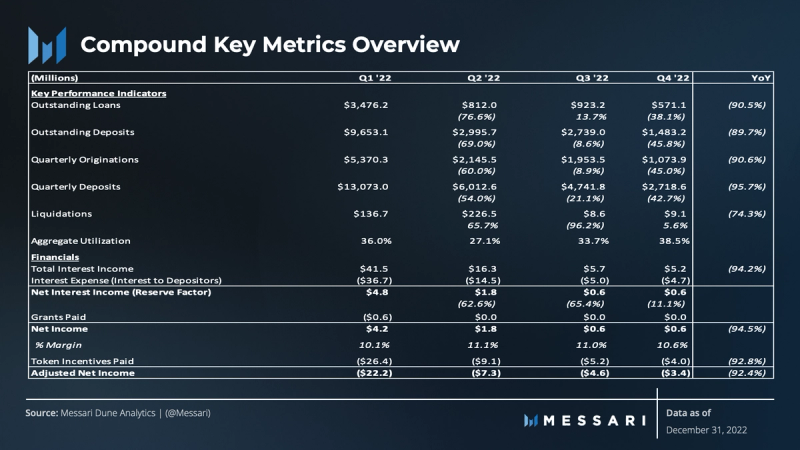
Performance Analysis
Macro Overview of Compound Markets
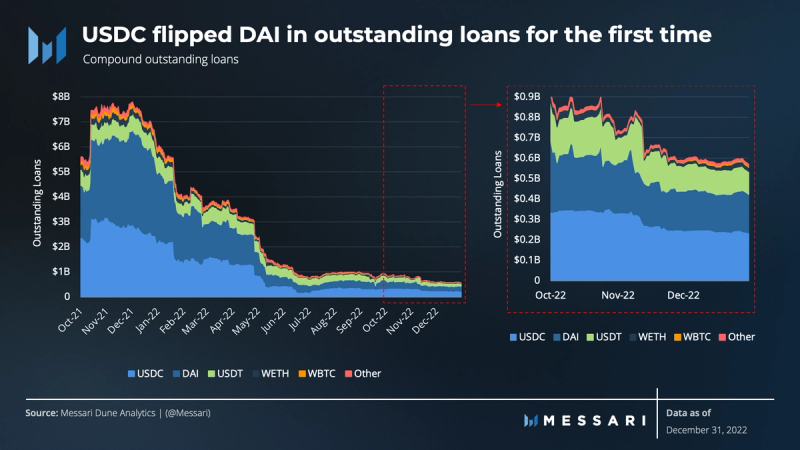
The overall demand for leverage on Compound remained low as outstanding loans fell 38% from $923 million to $571 million Quarter-over-quarter (QoQ). Year-over-year (YoY) outstanding loans were down 91%. However, the WBTC markets experienced a 283% surge in loan demand QoQ.
Loans denominated in Stablecoins continued to be the primary source of leverage in Q4, and for the first time in 2022r, USDC flipped DAI in outstanding loans, representing ~41% of Compound’s outstanding loan balance.

In Q4, the average annualized borrower rate reached 2.94%, up from 2.47% in Q3. The increase was reinforced by the 8.39% spike on November 9 due to a 52% surge in borrowings that day. This was likely a result of the USDT markets as USDT briefly traded below its peg to ~$0.9986, which also coincided with the FTX collapse. During the quarter, borrower rates fell as low as 2.48%, higher than the 2.21% floor of Q3.
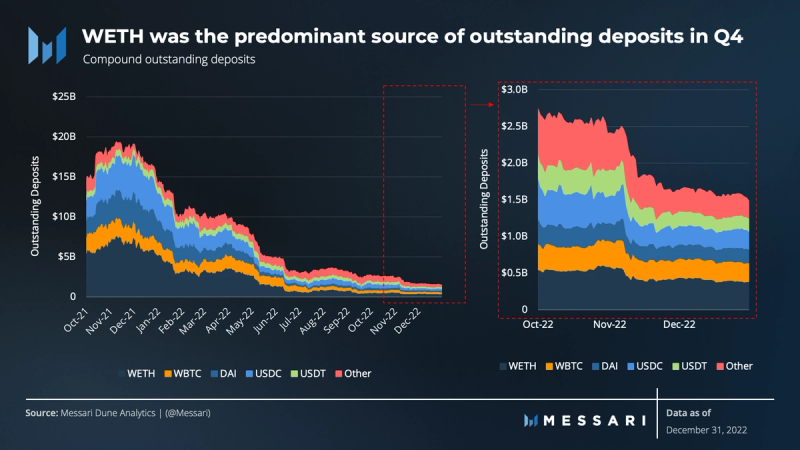
Outstanding Deposits continued to trend downward, falling 46% in Q4 and 90% YoY. This decline is a result of a weakened appetite for leverage disincentivizing depositors to keep their assets on the protocol due to unattractive depositor rates. WETH is now the predominant source of outstanding deposits in U.S. dollar terms by the end of Q4.
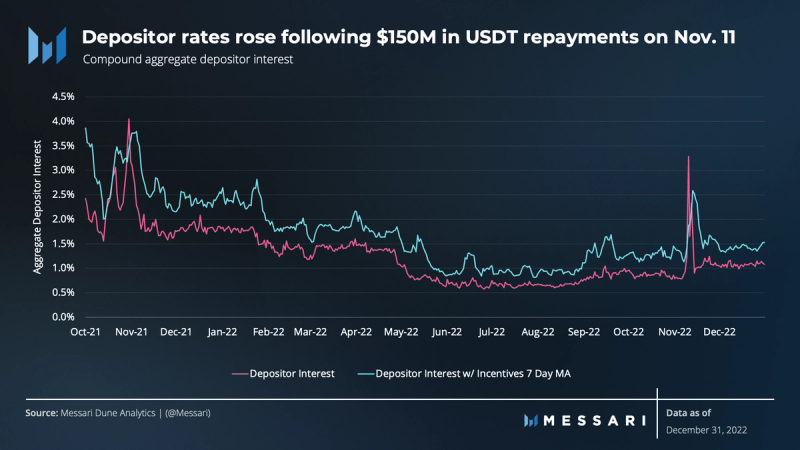
The aggregate depositor rate rose to 1.04% in Q4. Similarly, USDT primarily drove the spike in rates in November. Although depositor rates stabilized above 1.00% during the quarter, rates are expected to remain low until the demand for leverage picks up.
Utilization Ratio
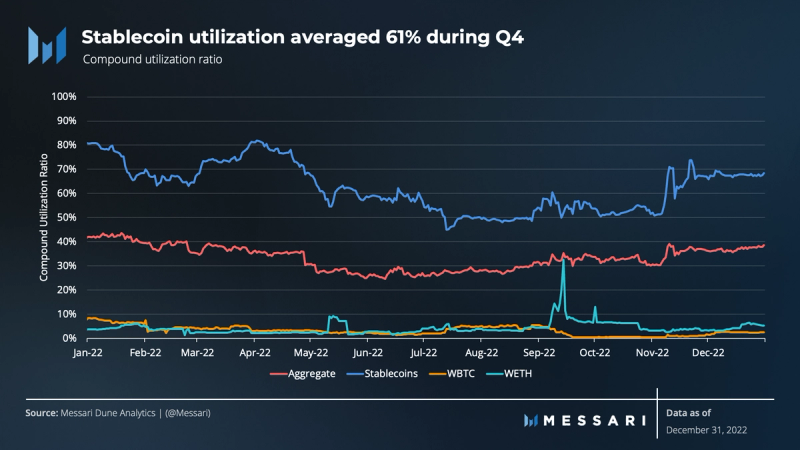
By the end of Q4, the aggregate utilization ratio grew to 38.5% from 33.7% the prior quarter. This was largely a result of declining deposits relative to loans outstanding. Stablecoin utilization remained strong, averaging 61% during the quarter, up from 52% in Q3.
Protocol Income
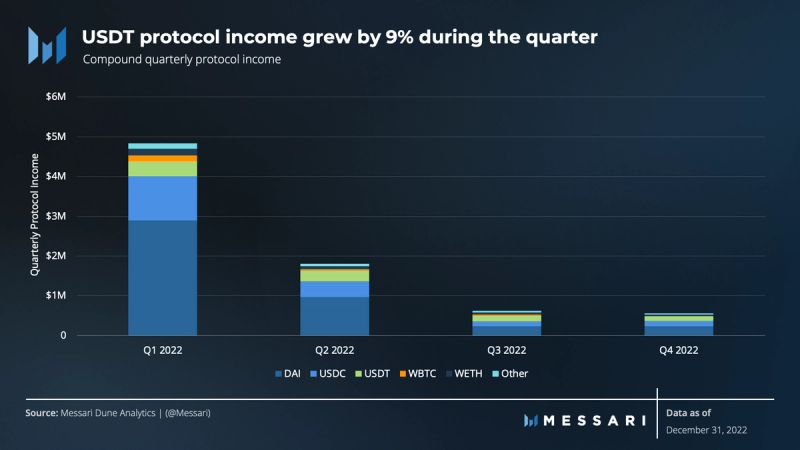
Protocol income, a product of outstanding loans, fell 11% QoQ, a rather modest drop from the 65% drop in Q3. Although DAI represented over 42% of protocol income in Q4, USDT protocol income rose 9%, whereas DAI was relatively flat (0.31%). The overall decline in protocol income is a result of weaker demand for loans.
Liquidations
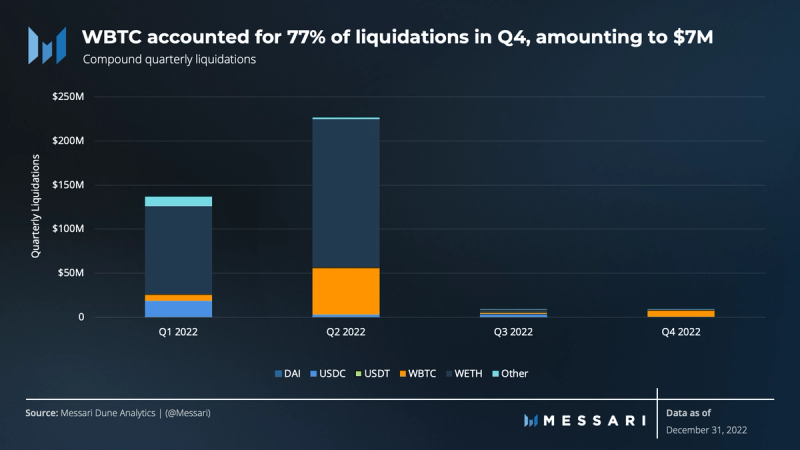
In Q4, liquidations grew 5.6%, from $8.6 million to $9.1 million. The vast majority of liquidations were limited to the WBTC and WETH markets. There were over $7 million in WBTC liquidations during the quarter, representing 77% of all liquidations. Whereas, WETH had $1.4 million in liquidations and accounted for 16% of all liquidations in Q4.
The liquidations in both WBTC and WETH correspond with the volatility that took place following the FTX collapse. The prices of BTC and ETH fell approximately 25% between November 7 and November 9, triggering these liquidations.
Incentives Paid

COMP incentives paid fell 24% QoQ to $4 million. The composition of incentives were mainly through DAI and USDC markets, with 44% market share for each. DAI paid out roughly $1.74 million in incentives compared to USDC’s $1.75 million.
Micro Overview – Compound’s Five Largest Markets
USDC
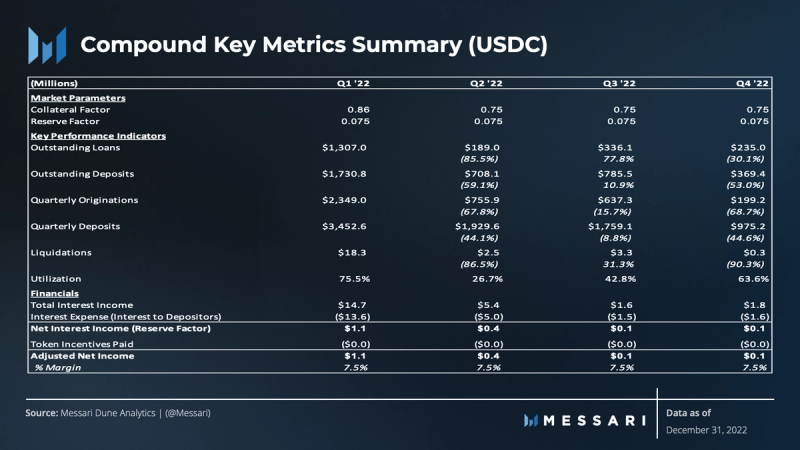
USDC gained dominance in both outstanding loans and deposits during the quarter, flipping DAI in loans for the first time. In Q4, outstanding loans fell 30% from $101 million, representing 41% market share in loans outstanding. Outstanding deposits fell 53% QoQ, likely a result of declining leverage demand and having the least favorable depositor rates of all stablecoins.
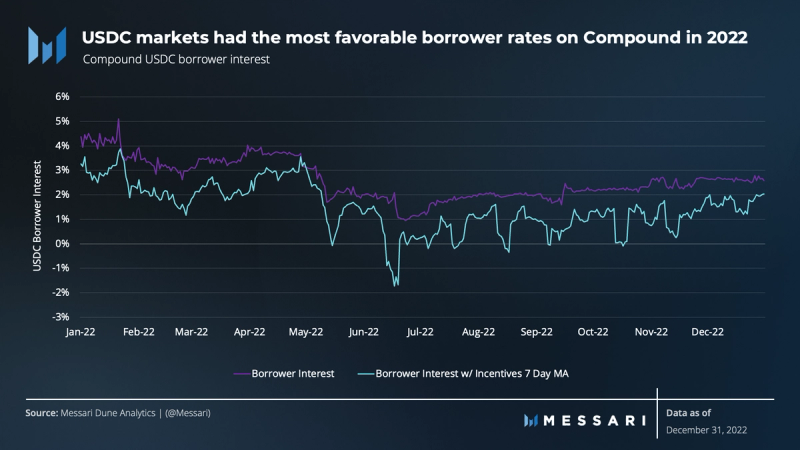
In Q4, loans denominated in USDC fell at a slower rate than other stables, coinciding with USDC having more favorable borrower rates during the year. On average, borrower rates were 2.49%, which is lower than that of DAI and USDT, attributed to DAI and USDT having higher utilization rates.
DAI
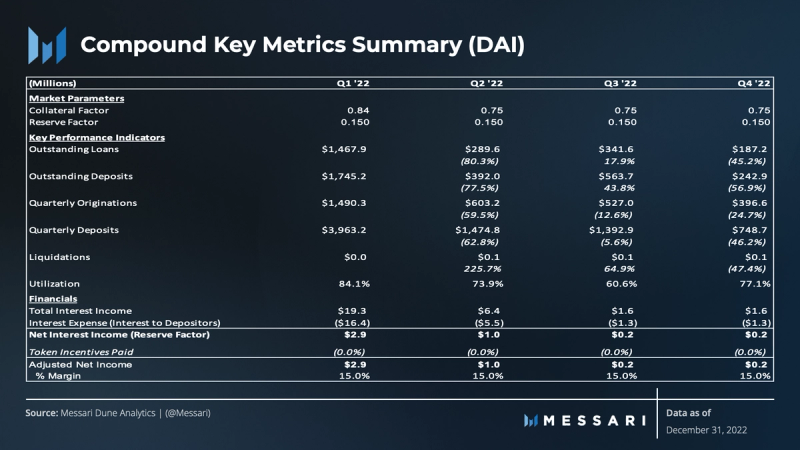
In 2022, loans denominated in the overcollateralized stablecoin, DAI, dominated Compound as the primary source of leverage. The deleveraging events that took place in the year caused DAI to lose its loan market share QoQ, as users unwinded collateral. The shift eventually allowed USDC to take the lead in outstanding loans by the end of Q4. Compared to loans denominated in other stablecoins, DAI fell the hardest, with a $155 million decline, or 45% QoQ. Outstanding deposits were drained over $320 million during the quarter.
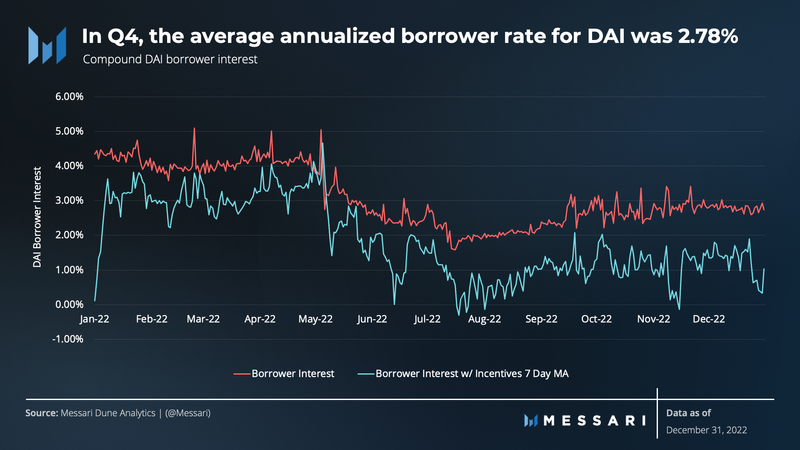
Rates reached highs of 3.42% and fell as low as 2.22% during the same period. Borrower rates gradually increased in the quarter as utilization grew from 61% to 77%. DAI’s circulating market cap has nearly halved since the onset of the year, contributing to the overall borrows.
USDT
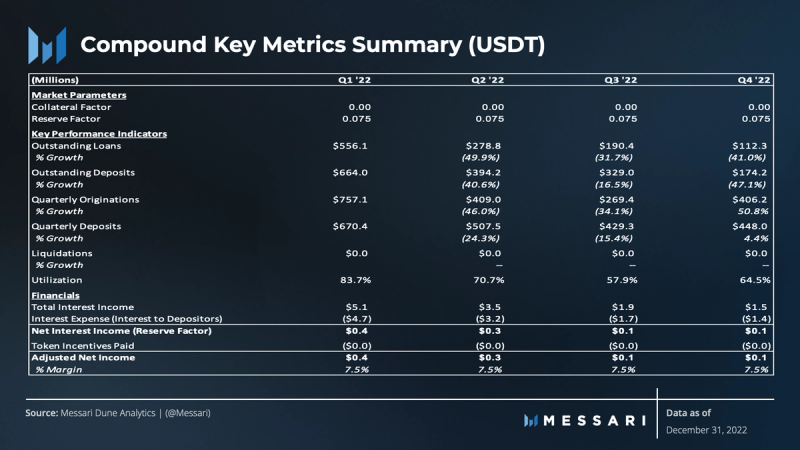
Although outstanding loans and deposits fell during the quarter, the USDT market was the only stablecoin to see any growth in new loan originations or deposits. The slight increase in deposits can be attributed to USDT having the most attractive depositor rates compared to other markets in Q4. On Nov. 9, 2022, immediately following the FTX collapse, outstanding loans grew 52% from $187 million to $283 million. Four days later, there were over $147 million in repayments. This activity is likely due to USDT trading below its peg during those days.
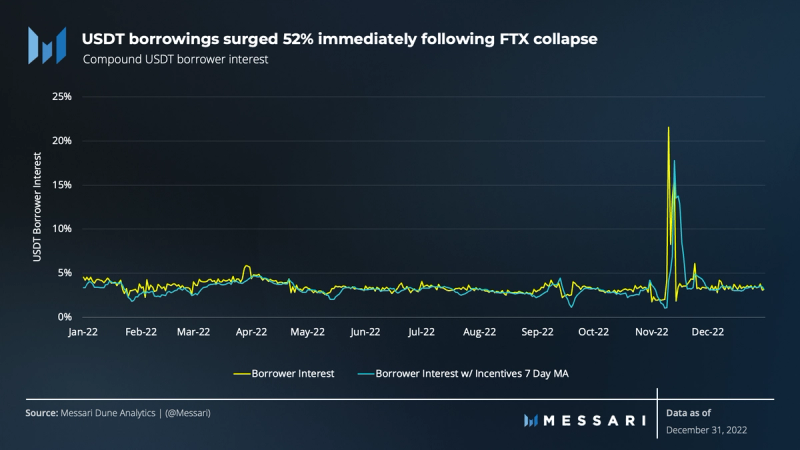
In Q4, the borrower rates for USDT were 3.85% on average, the highest of all stablecoin markets. Despite USDT having the most aggressive borrower rates, outstanding loans grew 18%. This is likely due to the overall USDT stablecoin market being nearly 50% larger than USDC as of this year.
WETH
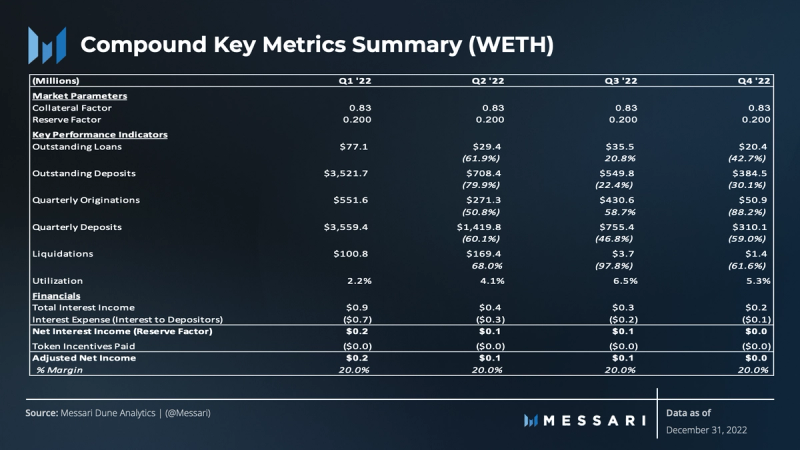
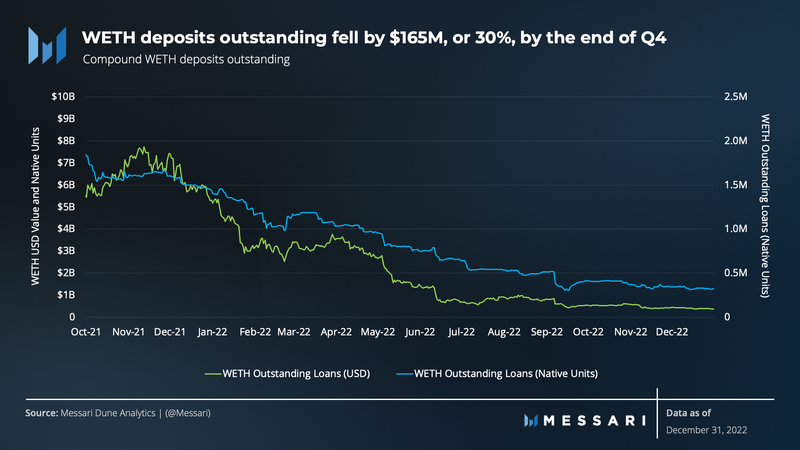
There were $15 million fewer outstanding loans in WETH in Q4, resulting in a decline of 43%. This is in addition to the roughly $1.4 million in liquidations that took place in November. The demand for loans declined immediately following the FTX collapse. However, since the collapse, there was approximately a 72% uptick in WETH loans in native terms or over $9 million.
WBTC
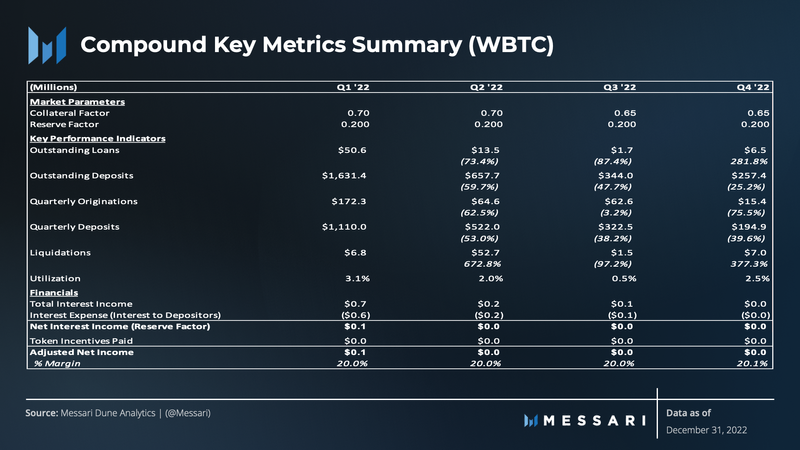
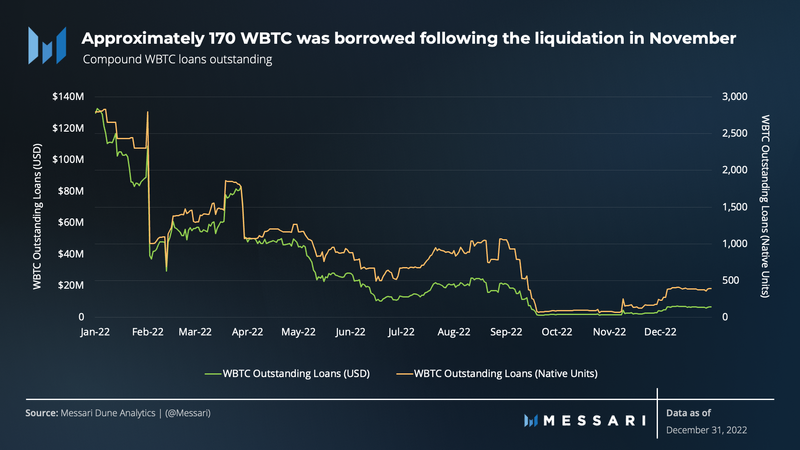
Outstanding loans in WBTC grew for the first time in 2022 by 283%, from $1.7 million to $6.5 million. In native terms, this equates to a 336% increase QoQ. The uptick in loan demand did improve utilization during the quarter but remained below 3%. The volatility caused by the collapse of FTX resulted in virtually all of the WBTC liquidations in the quarter, amounting to $7 million. Subsequently, users took on leverage immediately following the collapse, driving growth in loans in Q4.
Compound III (Comet)
Compound III launched in Q3 2022, featuring a single borrowable asset within each deployment. There were five deployments as of Q4 2022: ETH, BTC, LINK, UNI, and COMP. These assets can be used as collateral to borrow USDC. Although users can no longer earn interest on deposits in Compound III, users can now benefit from higher loan-to-value ratios and reduced risk of liquidations and penalties.
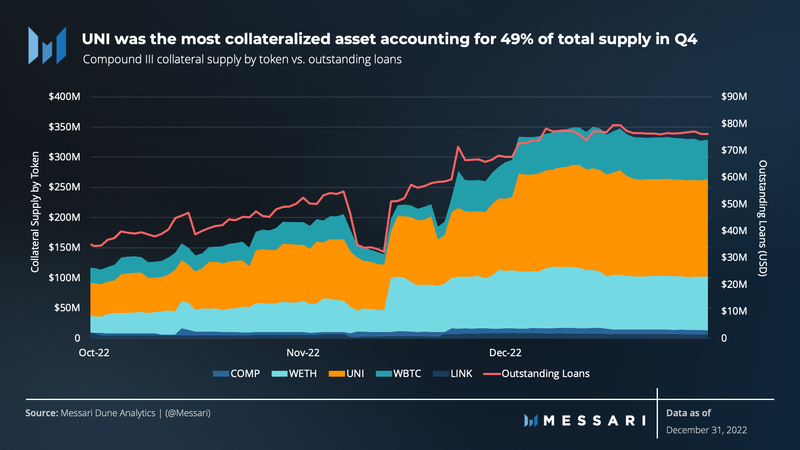
By the end of Q4, outstanding loans on Compound III more than doubled to $76 million from $35 million. There were more than $215 million in collateral assets deposited, a 179% increase QoQ. Over $2.2 million in liquidations across all markets during the quarter, was led by both WBTC and WETH due to steep price declines following the FTX collapse.
UNI, the Uniswap governance token was interestingly the most common collateral asset by the end of Q4, accounting for 49% of the total collateral supply. WETH and WBTC followed with 27% and 20%, respectively.
Qualitative Analysis
Governance & Key Events
By the end of Q4, there were approximately 11 executed proposals, many of which incorporated parameter changes, supply cap adjustments, and payment adjustments to OpenZepplin.
Parameter Optimization and Updates
During the quarter, various parameter change proposals were executed.
- Proposal-129 and 138 – Deprecating the FEI, SAI, REP, FEI, and WBTC (legacy) markets.
- Proposal-130 – Increasing the borrow cap for COMP and switch the interest rate model to replicate cUNI, improving borrowing costs across the utilization curve.
- Proposal-133 – Decreasing the SUSHI collateral factor from 73%-70%.
- Proposal-140 – Increasing the supply cap for UNI and Comet USDC market and decreasing the liquidation factor for COMP.
- Proposal-128 and 137 – Compound III supply caps for ETH, WBTC and COMP were raised to expand beyond its trial phase and double the WETH supply cap and update Comet implementation.
- Proposal-131 – As a risk mitigation strategy, ZRX, BAT, MKR, and YFI markets on Compound III paused supply to prevent potential oracle manipulation based attacks (e.g., Mango Market exploit).
- Proposal-132 – Liquidation Event Handling and Reserves.
- Proposal-135 – Adjust borrow caps for ten V2 assets.
Compound Extensions
Extensions are optional add-ons built by community developers to help improve Compounds’ user experience. They allow users to leverage Compound III’s new account management functionality to add new features to an account such as:
- Automation
- Composability with other DeFi protocols
- Position management
- Run without any permissions and simply provide info like alerts
Grants Program Overview
The Compound Grants Program (CGP) 2.0 was approved for a $800,000 fund spread over two quarters. It proposed $200,000 to compensate the grants committee, allocated across four domains.
- New protocol ideas, dapps, and Miscellaneous
- Security Analysis Tool and Security Bounties
- Developer Tooling
- Multichain Strategy
Closing Summary
Compound faced another difficult quarter as outstanding loans fell due to a diminishing appetite for leverage. However, the recent deployment of Compound III has witnessed early successes as it introduced a more user-friendly lending platform. Compound III’s outstanding loan balance doubled in Q4 and also saw nearly a 180% increase in a deposit of collateral assets.
The Compound Grants Program 2.0 was approved in Q4, following a pause for several quarters. Funds will be allocated across four strategic domains to help develop new protocol ideas, developer tooling, security tools and implementing multichain strategies. The recent launch of Compound Extensions is a great example of new development and opportunities for users and the community to onboard useful tools to improve the user experience.



















